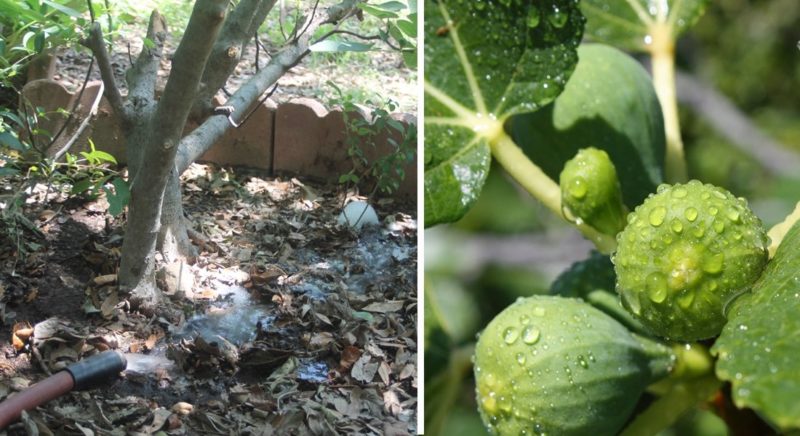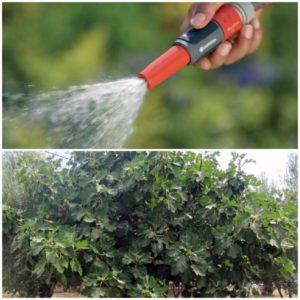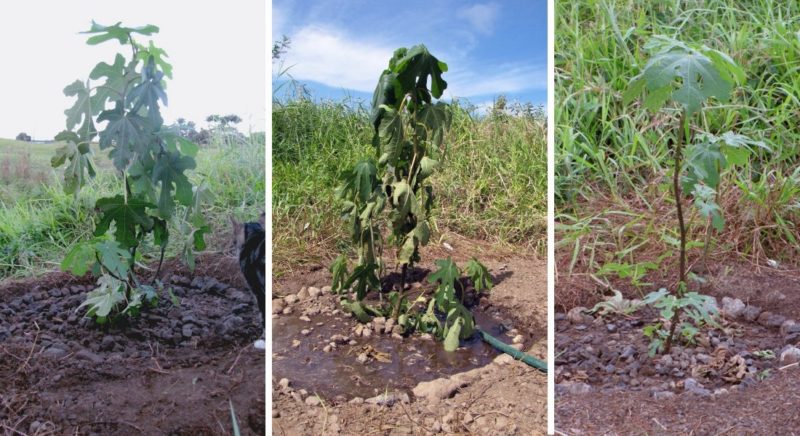How much and how often to water figs in the summer: instructions for beginners
Fig is a tropical fig tree. It is grown in Russian gardens and orchards in the open ground, planting on warm and fertile lands. Fig fruits are valued for their beneficial qualities and vitamin composition, and are also used in cooking - they prepare aromatic homemade jam or fig pies. One of the necessary conditions for growing an exotic tree is competent summer watering. How often to water figs in the summer and how to do it correctly, we will consider in the article.
The content of the article
Do I need to water the figs in summer

Fig watered throughout the summer. The plant loves water, but does not tolerate waterlogging. During watering, it is important that the water penetrates deep into the roots, and does not remain on the surface of the soil and does not create a dense crust under the influence of the sun.
Gardeners pay attention to weather conditions: the hotter the summer, the more often and more abundantly they water the figs. The variety, plant age, ripening period and cultivation features.
Regular and competent watering guarantees the correct development of the crop and rich yields. Drought leads to the fact that the shoots dry out and lose the ability to bear fruit, the plant becomes sick and dies. In addition to watering, it is recommended to pay attention to sprinkling in the summer - with its help, the optimal moisture level is maintained for the proper development of the tree.
How often to water
The frequency and amount of watering depends on many factors. Young trees moisturize weekly, spending 5 to 10 liters of water per plant. More adults - less often: add about 8-10 liters of water once every 2 weeks. If there are signs of drying out (wilted shoots, gray-green leaves, deformed fruits), the amount of water is increased to 15 liters under one tree once a week. If summer is rainy, decrease.

Irrigation water requirements
Suitable water for irrigation is soft, free of chlorine and lime, previously set in the sun. Its temperature must be at least + 20 ° С. Experienced gardeners recommend using melt or rainwater. Simple drain structures are installed on the site, through which moisture enters empty barrels of plastic or iron. Rain and melt water is enriched with natural oxygen, so figs are less likely to get sick.
If the summer is dry and there is no rainwater, tap water is used. The disadvantage is that it contains chlorine and lime and is hard. To soften the water, gardeners add 2 drops of lemon juice to 10 liters. Also, apple cider vinegar is used to soften - 10 drops are dissolved in 1 liter of water.
Attention! Do not water figs with water from open reservoirs - swamps, rivers or lakes. It can contain dangerous fungi and pathogens that cause tree diseases. Due to such watering, figs will get sick with coral spot, anthracnose or gray rot.
What can be added
In order for watering to bring double benefits, once a month gardeners use not plain water, but an infusion of herbs: chamomile, calendula, nettle, burdock, tansy, sage. The procedure increases the number of ovaries on the tree and prevents the appearance of pests: whiteflies, greenhouse thrips, earwigs, nematodes, spider mites. Moisten the figs in the early morning, before sunrise.
To increase the yield, figs are watered with banana peel infusion. It is poured with water and insisted for 3-4 days, after which it is brought under a tree into specially prepared holes 8 cm deep.Such watering is aimed not only at moisturizing, but also at nourishing the tree and replacing organic fertilizing.
How to properly water figs in summer
Among all types of irrigation for figs, ordinary (root), sprinkling and liquid fertilizing are more suitable than others. It is recommended to alternate them with each other so that the hydration of the plant is balanced..
Regular watering is used in the morning hours before the onset of heat or in the evening after sunset, when the temperature drops and the sun's rays do not cause burns. Water is brought into special holes near the tree or under the trunk. The first method is preferable, since moisture is distributed more evenly, and does not accumulate in one place. After the procedure, the earth is loosened to saturate it with oxygen. Next, the figs are mulched - hay, sawdust, fine gravel or dry foliage are poured under the tree. Mulch retains moisture.
Sprinkling is a method of watering using a special machine. The procedure has a positive effect on the water-air regime of the soil, due to which the water does not stagnate on the surface and is gradually absorbed. Drops of various sizes and intensities are distributed over the fig tree. The disadvantage of overhead irrigation is that it is only suitable for large plantations, and machine maintenance costs many times more than conventional irrigation.
Attention! For small garden plots, summer residents use a spray bottle with water - they distribute moisture over the plants in the morning or evening. The main thing is not to do this when the sun is shining - leaf burns are guaranteed.
Liquid feed can be organic or mineral. Gardeners use manure, superphosphate, potassium salt, urea, wood ash. The frequency of applying liquid fertilizers is once every 2-3 weeks. Organics and minerals alternate. Top dressing is diluted in a bowl and poured under the root or into the holes. For nutrients to be absorbed faster, figs are mulched. The thickness of the mulch layer should be 3-4 cm.
What mistakes to avoid
Errors during watering are made not only by novice gardeners, but also by experienced summer residents. Because of this, figs slow down in growth, become covered with burns or even die. Several common mistakes:
- The tree is often watered, but little. This method leads to the fact that water is available only for a part of the plant; it does not penetrate deeper to the roots. The surface layers of the soil dry out quickly, becoming unsuitable for growing a capricious exotic tree. Watering should be balanced. General recommendation: Pour 10 liters per plant every 2 weeks.
- The tree is watered from a hose with a strong stream of water. Even if this does not lead to serious diseases or a decrease in yield, the decorative qualities of the plant will deteriorate. It is better to buy a watering can and water the figs carefully, avoiding damage to the roots and ripening fruits.
- Water so that a significant part of the water ends up on the leaves. It doesn't have to be like that - water is meant to feed the roots, not the leaves. The jet is directed directly to the root. And you can moisten the leaves during sprinkling.
Watering figs when planting

Figs are planted in summer cottages in nutritious and loose soils with neutral acidity. A pre-planting hole is fertilized and a drainage layer is laid so that moisture does not stagnate. The first time the figs are moistened immediately after planting - a bucket of water is poured under the seedling and mulched. The next time the plant is watered only after 2-3 weeks.
During flowering and fruiting
During the flowering period, the figs are watered based on their age. Up to 10 liters of water are spent on a tree up to 2 years old, up to 15 liters of water on plants aged 2 to 10 years. After 10 years, figs are watered depending on whether they bear fruit or not. If the plant is healthy and productive, 10-15 liters are spent on it.
The procedures are stopped 10 days before fruiting and at the time of harvest. After that they are watered once and prepared for winter - they are cut off and covered. The next procedure takes place only in the spring.
Experienced gardening tips
Watering of figs begins at the end of May. Previously, they do not do this, since there are still reserves of rain and melt water in the soil. In addition to this rule, experienced gardeners share other useful tips:
- After each watering, the soil is loosened. The procedure serves to prevent diseases and insect pests, increases the moisture content of the soil and prevents the development of weeds.
- Summer residents use sprinkling only if the weather is hot. If the climate is humid and humid, do not apply the procedure.
- Pour the figs with melt, rain or tap water. A suitable temperature is around + 20 ° C.
- During fruiting and 10 days before, the plant is not watered.
It is interesting:
Conclusion
Watering figs in the open field is carried out on average 1 time in 1.5-2 weeks. Up to 10 liters of water are spent on a young tree, about 15 liters on an adult. The water is preliminarily defended and heated in the sun if it is cold. Once a month, instead of watering, they use liquid top dressing - they bring an infusion of herbs or banana peel under the tree. If the summer is dry and hot, sprinkling is carried out - water drops are sprayed over the plant. After the procedure, the soil is loosened and mulched. Proper tree care guarantees a rich harvest.